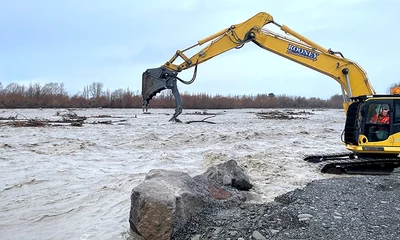Mackenzie pushes for flood protection injection

Political pressure continues to build on the Government to open its flood protection wallet, with Environment Canterbury’s Ashburton councillor Ian Mackenzie pushing for change.
Mackenzie and ECan wanted the Government to invest $150m per year to co-fund flood protection infrastructure across the country.
“To do the capital works we need, we really need that co-funding contribution from central Government.”
Mackenzie’s message comes as Mid Canterbury continues its latest flood clean-up after heavy rain lashed the district earlier this week.
Though it was nowhere near as bad as the May 2021 flood, when the Ashburton River was flowing twice as high as it was this time round, the flood had still left its mark in the district.
Mackenzie said that it was a matter of when, not if, the next big flood comes, but any change to how a district prepares for it “all comes down to money”.
With climate change forecast to produce more frequent flood events, Mackenzie said it’s more cost effective to fund preventative measures than to pay for clean-ups.
“Co-funding flood protection infrastructure is one of the most effective ways it can spend climate change money.
“We can spend dollars very effectively to control and manage flood events in our rivers.”
ECan already spends around $15m annually on flood mitigation to protect $110 billion of the region’s assets.
Mackenzie said it’s not just about protecting farms, but about protecting roads, bridges, community assets, businesses, and people’s properties.
After another flood event, there was now pressure on the Government to act.
Since the devastation of the May 2021 flood, the Ashburton River floodbanks had been fixed before this week’s flood.
But there had been some erosion, partly because the vegetation hadn’t had time to establish.
“The bits we repaired actually held up better than other patches,” Mackenzie said.
Gravel extraction work also helped the situation, but it would cost millions to remove, he said.
“In places, we have been able to do it, and others we haven’t done enough of it, so there is still a lot of work to be done.
“There is a lot more shingle to come out and that’s just a question of money.”
- By Jonathan Leask

